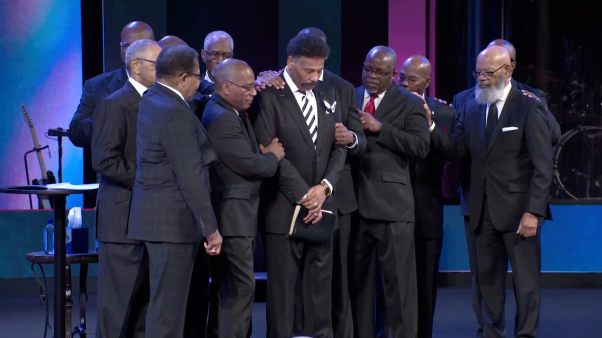Present day problems in hermeneutics.
Current hermeneutical debates question whether we can ever know what the writers originally meant.
The discipline of hermeneutics is emerging as the new dominant movement in both European and American theology. The number of articles and books appearing on this topic is matched only by the magnitude of the questions they are raising.
These questions are not the traditional hardy annuals: What is literal and what is figurative? What is descriptive reporting and what is normative teaching? Instead, our generation is being invited to ask the most fundamental question of all communication and interpretation. It is, surprisingly, in the area of general hermeneutics that the debate has aroused the sharpest disagreement. The implications of this debate for the evangelical and for the interpretation of Scripture are enormous. Our energetic entry into this discussion is thus no longer an optional luxury; it must be placed highest on our list of investigative priorities.
The New Orientation
The basic crisis is this: hermeneutics is more a matter of the text interpreting itself and the interpreter, than it is our interpreting the text. It is not the former focus on “What does the text mean?” or “What did the author mean?” Rather, we now ask the text to interpret us, and to become itself a new event as we read or hear it.
This new orientation has sprung from the philosophical roots of Martin Heidegger, who concluded that understanding happens when the reality to which language points becomes present for the individual and merges in such a way as to coincide with his own present reality.
Currently, however, the most important theoretician of philosophical hermeneutics is Hans-Georg Gadamer. In Wahrheit and Methode (1960) he accepted and extended Heidegger’s thought. Thus by 1964 James M. Robinson could speak of the school of “The New Hermeneutic.” At the heart of Gadamer’s concern was the premise that the meaning of a text was not the same as the author’s meaning. The author’s meaning was, in any case, inaccessible to us. Instead, the meaning of a text was in its subject matter, which was at once independent of both the author and reader, and somehow also shared by both of them. Moreover, no one could ever say this is the meaning of a text, since the number of possible meanings was practically endless and constantly changing. And, argued Gadamer, what a text meant to an author could not be reproduced in the present. The past was alien to the present, for differences in time necessarily involved difference in being.
If Gadamer signaled a new modern consensus for what may be called the Heideggerian version of hermeneutics, Emilio Betti, an Italian historian of law, and E. D. Hirsch, Jr., an American professor of English, represented the minority opinion that was trying to reinstate the older form of hermeneutics. Both scholars insisted on two basic distinctions: “meaning” was that which was to be found in a text as indicated by its grammar, the author’s use of his words, and his truth-intentions; and “significance” merely named a relationship between that discovered “meaning” and another person, time, situation, or idea. Thus meaning was unchanging and single, while significance did and must change since interests, questions, times, and concerns of interpreters also changed. Betti did acknowledge that in the interpretive process the interpreter involved his own subjectivity. But if the interpreter does not succeed in penetrating beyond that subjectivity, Betti cautioned, he most likely will achieve nothing more than projecting his own ideas and preferences onto the text he honestly believed he was interpreting.
Of course, Gadamer justifiably insists that every interpretation also involves an application to the present. This is precisely the situation in interpreting legal cases to locate precedents for the contemporary situation. But according to Betti and Hirsch the significance of the text is grounded in the text itself as judged by the author’s use of grammar. Gadamer, however, is too preoccupied with the interpreter’s assignment of meaning to an object, and with the easy equation of this subjective assignment to the text’s meaning.
Both Betti and Hirsch insist that the price for ignoring this distinction and definition of meaning and significance is high. It will jeopardize the integrity of all that is objectively valid in the whole spectrum of the humanities, for there will be no method of validating and testing which meaning more adequately represents the correct one. All criteria for measurement are abandoned for purely subjective and personal replacements.
Understanding of the objective model argued here (and we definitely prefer Betti and Hirsch to Gadamer) is like grasping the inner logic and coherence of a mathematical proposition or the working parts of a machine (Otto Bollnow’s illustrations). Nor can such understanding be “better than an author’s,” unless we mean “better” in the sense that we can complete what is unfinished in the subject, or that we can better clarify certain assumptions or guiding principles that the author’s work uses without consciously reflecting on them or explicitly stating them as such.
When the New Hermeneutic or aspects of it are applied to the biblical text, the results are startling. Every text has a plethora of meanings that are said to exist without any norms for deciding between which are right and which wrong. If and when norms are allowed, by some evangelical forms of this hermeneutical revolution, they still stand opposed to what the author intended to say through his use of these words. Rather, it is claimed that the text itself is autonomous and free from the author once he has written it; it is ready only to be shaped by our act of understanding it. This we cannot accept. Should this argument persist, this writer would recommend that beginning immediately, all explanations of the theory of understanding emanating from this Heideggerian fountainhead be interpreted on the basis of their own theory and not on the basis of the objective single meaning theory they are attacking. In fact, one of the best critiques of this position is deliberately to take the exact opposite point of view as the meaning we [that is, “what it means to me”] allegedly receive from their statements—which eventually makes communication impossible.
The New Contextualization
The crisis over the general theory of understanding (= general hermeneutics) and its high price of an eventual loss of communication is not the only problem we face in biblical interpretation. Recently, Charles Taber has also raised the question of whether one’s hermeneutical stance is not part and parcel of the cultural heritage each received (Gospel in Context I, 1978, pp. 8–9).
Taber’s point is that possibly there are as many proper, yet differing, approaches to the text of Scripture as there are cultures and societies. In Taber’s curious line of reasoning, the precedent and legitimization for so many hermeneutical approaches to the Scripture may be found in that same text. In his view, the New Testament writers practiced a form of rabbinic hermeneutics in that they appealed to Old Testament citations which said “X was the fulfillment of Y,” when to Western moderns it seemed to be no more than “X reminds us of Y.” Yet contemporary Western Christianity rejects this hermeneutic, presumably because of our cultural heritage.
If Taber is right in his analysis of the New Testament, his suggestion might follow. But his question ought not to be as troublesome as it appears. As we have argued and documented elsewhere (“Legitimate Hermeneutics,” Inerrancy, ed. N. Geisler, Zondervan, 1979), the general rules for interpreting oral or written speech are not learned, invented, or discovered by men; rather, they are part and parcel of our nature as individuals made in the image of God. This art has been in use since God gave the gift of communication and speech itself. Thus the person spoken to is always the interpreter; the speaker is always the author.
This is not to argue that everyone is automatically and completely successful in the practice of the art and science of hermeneutics just because each possesses this gift of communication as part of the image of God. Precisely at this point the distinctiveness of the cultural context of the reader/interpreter becomes most embarrassingly obvious. Certainly even when the speaker and listener/reader share the same culture and age there may still be some general subjects and vocabularies that may not be a part of the interpreter’s experience and therefore his ability to interpret is frustrated. In this case, it will be necessary for the interpreter to engage first in some serious study before he can be a successful interpreter.
But when the interpreter is removed from the original author by many years, governments, societies, and even religious conditions, how can the general rules for interpreting be part and parcel of our natures as made in the image of God? Again, the answer is the same. This question merely confuses one type of learning—which is only preparatory and an antecedent study—with the task of interpretation which still must follow. Had birth and providence favored us so that they would have been present and would have participated in that culture from which the writing emanated, we could have dispensed with this search into backgrounds, culture, and even at times languages. But we would still have been obligated to engage in the task of interpreting the text. Thus we still contend that the principles of interpretation are as natural and universal as is speech itself. To argue the reverse (in human speech which assumes someone is listening with understanding) is either to involve oneself in downright duplicity or ultimately to be reduced to a solipsism where only I speak, and only I know what I am saying.
All men and women in all cultures are made in the image of God. And when this fact is joined with a biblical concept of truth as having an objective grounding and reference point in the nature of God and in the doctrine of creation, the possibility for adequate (even if no one knows comprehensively except God) transcultural communication has been fairly provided and secured.
Furthermore, few have argued in this generation more strenuously than this writer against inference that the New Testament writers were following midrashic or pesher types of exegesis when they cited passages from the Old Testament to establish doctrine. Taber’s charge is an old one. But to quote only one source from 1885, Fredric Gardner in his book The Old and New Testament in Their Mutual Relations was right in asserting: “In all quotations, which are used argumentatively, or to establish any fact or doctrine, it is obviously necessary that the passage in question should be fairly cited according to its real intent and meaning, in order that the argument drawn from it may be valid.”
He challenged the very charge currently made: “There has been much rash criticism of some of these passages, and the assertion has been unthinkingly made that the Apostles, and especially St. Paul, brought up in rabbinical schools of thought, quoted the Scriptures after a rabbinical and inconsequential fashion. A patient and careful examination of these passages themselves will remove such misapprehension” (pp. 317–18). This examination we have undertaken in a number of articles elsewhere and have found it entirely correct.
Nevertheless, none of the above arguments should be interpreted as a denial of the presence of cultural items in Scripture or that there are real problems in transcultural communication. We have merely contended that there is in principle the possibility of communicating with and understanding men and women in other cultures and times than our own.
Hermeneutics enters into this discussion when we encounter truth that comes in a cultural vehicle or context. It then becomes the interpreter’s job to recognize the vehicle, illustration, or clothing for what it is without evaporating the revelation of God one whit. This task, we are learning, is easier said in theory than accomplished in practice. But never mind the difficulty; Peter’s apostolic status and revelatory stance did not guarantee even to him any kind of automatic and trouble-free path to interpreting some of his fellow apostles’ meanings. In 2 Peter 3:16 he frankly admitted that his “beloved brother Paul” had indeed written “some things hard to understand” that were liable to be twisted by the ignorant and unstable to their own undoing. And what was true for Paul, Peter allowed, was also possible in “the other Scriptures.” The church must give more attention to this aspect of hermeneutics than it has in the past. (See this writer’s seminal suggestions for some guidelines in the essay mentioned above, “Legitimate Hermeneutics.”)
The New Rule Of Faith
One more current crisis needs to be discussed here. This has its roots in Origen’s misappropriation of the words from Romans 12:6, “according to the analogy of faith” (which in the context of spiritual gifts did not refer to a body of truth) and in the Reformers’ proper rejection of the Glossa ordinaria, a commentary that preserved a uniformity in all matters relating to doctrine and discipline. The Reformers’ objection to this Regula fidei (Rule of faith) set up by the church of Rome was that it was an authority independent of Scripture.
By what means, then, could the Reformers determine which interpretations were valid and which were not true? They could not appeal to any new rule of faith, for they had by now trumpeted forth the principle of sola scriptura: doctrine and discipline must now be based on Scripture alone. The solution was to argue that the Bible was to be its own interpreter. In opposition to the principle that allowed tradition or the Glossa ordinaria to interpret Scripture, the Reformers championed the hermeneutical principle that “Scripture interprets Scripture,” commonly called “the analogy or rule of faith.”
Unfortunately, contemporary men and women pervert this dictum that “Scripture interprets Scripture” when they fail to realize that the Reformers used it only as a relative expression aimed especially at tradition; it was never intended to be understood as an absolute and positive principle that excluded learning, grammar, syntax, and the need of commentaries, or a trained ministry that would return to the original languages for a detailed and more precise understanding of the text. Otherwise, why did Calvin and Luther also write commentaries and preach God’s word to the church?
Some will then ask, “What has happened to the teaching about the ‘perspicuity of the sacred writings’? Are not the Scriptures ‘clear enough’ so that the simplest person can understand all that is in them?” But here again, we respond that the Reformers never meant to declare that the Bible was totally perspicuous to all alike. Rather, perspicuity was again a relative expression and not an absolute one that claimed everything in the Bible to be equally clear and apparent to all readers at all times. Instead, it too was a word aimed at the objectionable application of tradition to the exposition of Scripture. As far as the Reformers were concerned, the Bible was sufficiently perspicuous without the need for the church’s tradition or regulation of interpretation. The Bible is sufficiently clear in and of itself to bring its learned and unlearned readers into an understanding of the basic message of salvation and a walk with God.
Yet there was at least some room left for ambiguity, if not outright opposition between principles, when the Reformers went on to illustrate and define their further use of the “analogy of faith.” Some passages of Scripture, the Reformers assured us, could only be understood by the analogy of faith. In some passages, Luther confessed, faith might force us to abandon the natural or grammatical sense of a passage!
The corrective for some of the past and present cries generated by an improper or premature use of the analogy of faith, is the recognition that there is indeed a theological aspect to interpreting Scripture. But this analogy, when used as a hermeneutical tool, must be carefully restricted to those passages that preceded in time the passage currently under study. It must be controlled diachronically and put into the sequence of the progress of revelation. And to minimize subjectivity, this should be done only when the passage being exegeted warrants it. Such clues in the passage under examination will be: (1) the use of terms that by now have taken on technical status, (2) the allusion to the same events, and (3) the quotation of or general reference to previous passages that are now part of the Holy Scriptures in the possession of that author and audience to which this new word is being delivered. Only such a procedure of limiting ourselves for exegetical purposes (doing systematic theology is another matter which ought to follow this step in any case) to the “informing theology” or that “rule of doctrine” in the existence when this new passage came in the progress of revelation will save us from allowing the analogy of faith to undercut the principle of sola scriptura. Otherwise, we will have quietly restored tradition to its previous place of authority alongside Scripture.
Conclusion
These are not the only matters troubling the hermeneutical house, but these three crises are, in our estimation, each in and of themselves sufficient to bring the whole orthodox case for Scripture tumbling down. It would be the ultimate irony if our generation were to be noted as the generation that contested most earnestly for the sole authority and inerrancy of Scripture as its confessional stand, but which generation also effectively denied that stance by its own hermeneutical practice and method of interpretation. This in itself, given the contemporary pressures, is reason enough to call the evangelical community throughout Christendom to a whole new hermeneutical reformation. We trust that under God we may be so favored in our generation.
The Naming
I am that I am
could have
reigned alone the universe
of fuguéd echoes
but named himself again:
Word (for those who would have ears)
Spirit (for those who would someday listen)
and they
one
birthed our fragile souls,
named themselves again:
Father. Redeemer. Comforter.
SUSAN MIRIAM ZITZMAN
G. Douglas Young is founder and president of the Institute of Holy Land Studies in Jerusalem. He has lived there since 1963.










